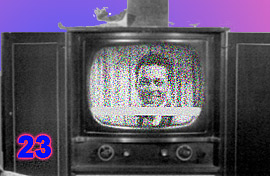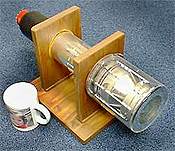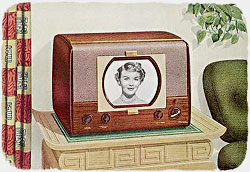Film, Radio and TV - 23 |

Television--
In the beginning, a snowy picture with a horizontal bar rolling through it (like the one shown above) was the best many TV viewers could hope for. For thousands of people living some distance from the large cities even this kind of picture required the installation of a tall antenna next to their houses. Often, they could only get only one station--and only then if atmospheric conditions were good. But, despite the difficulties, it was television, and it marked the beginning of a phenomenon that was to have a major impact on news, advertising, film, radio, and the world--not to mention how millions of people would spend their leisure hours. Although television is blamed for everything from crime to tooth decay, television has contributed many positive things to society, as we will see when we explore this medium in the upcoming modules. |
For decades before its invention, something called "television" had been part of science fiction stories. Discovering how to send audio through the airwaves opened the door to the possibility of television, but video was far more complex. It was correctly reasoned that since pictures had millions of times more data than audio, pictures would have to be broken down into bits of information (a data stream) before being transmitted. The first application of this This was done by wrapping a photo around a drum, as shown on the right, and rotating the drum as a light-sensitive photocell moved over the image picking up brightness differences. The photocell created voltages that were amplified thousands of times and then sent by telephone lines to the subscribing newspapers. At the receiving end, somewhat the reverse took place. A piece of photographic paper spun around on a cylinder within a light-tight enclosure. The intensity of a pinpoint of light focused on the paper varied with the signal being picked up by the originating machine. When the scan was finished, the paper was taken out in a darkroom and processed as a photographic print. Wirephoto machines established the basic concept of scanning pictures a line at a time. But still photos are not motion pictures. You may recall from an earlier module that experiments with film demonstrated that if a series of pictures were presented at a rate of about 16 or more per-second, an illusion of motion could be created. So the problem became one of electronically transmitting a series of still pictures every second. To do this the wirephoto approach of transmitting still photos--which originally took about 20 minutes just to transmit one picture--would have to be speeded up millions of times.
Many countries lay claim to inventing television, and without a doubt, engineers in several countries developed various early approaches to transmitting pictures. Early approaches were based on mechanical devices using a kind of Even with the obvious limitations, some TV transmitters went on the air using mechanical approaches. The first all-electronic TV programming was launched by the BBC from Alexandra Palace in London in 1936. Unlike the mechanical systems, this approach was the direct precursor to today's all-electronic approach to transmitting TV pictures. The BBC system was developed by Marconi, the father of radio. (Interestingly, Marconi's work, specifically the effect that aircraft had on the transmissions, led to the development of radar, which helped the RAF win the Battle of Britain.) In the United States, four people are given credit for major inventions leading to television: Philo T. Farnsworth, Allen B. DuMont, Charles Jenkins, and Vladimir K. Zworykin. Philo T. Farnsworth, an American engineer, who is most associated with the invention of TV, rejected the mechanical approach and decided that the only thing fast enough to scan a moving image was a stream of electrons. In 1926, he was trying to construct a TV receiver in the dining room of his Hollywood, California apartment. According to his wife, although constant "pops," "sizzles" and "bangs" came from the experimental TV equipment, these were not as bad as the terrible acidic smell that filled their apartment. Mrs. Farnsworth appears to be the first person to go on record as complaining, "television stinks!" Farnsworth not only had problems with his wife. Since he had the blinds pulled on his house during the day (to better see the experimental TV sets), the neighbors and police reasoned that he must have been doing something illegal--probably brewing alcohol. They raided his apartment, and, although mystified by what they saw, they at least they didn't throw him in jail. Despite his problems, Farnsworth developed the basic element of a TV camera: a dissector tube that used a moving stream In the closeup of a black and white TV screen on the right you can see the individual lines that comprise this type of TV picture. This scanning approach is still used today, although with today's color systems the scanning process results in millions of illuminated colored dots.
Once the problem of how to dissect images and sequentially transmit them through the air by means of radio waves was solved, we had the central elements of the television equation. The television process is explained more fully In case you play trivia, you may want to keep the title, "The Queen's Messenger," in mind. It was the first television drama to be broadcast in the United States. It was transmitted in 1928 from a General Electric station in Schenectady, NY. There were no TV sets in homes at that point, so the ratings weren't all that impressive; but, at least, the experiment was successful.
A few years later, the RCA Corporation put the ideas of Philo T. Farnsworth, Allen B. DuMont, Charles Jenkins, and Vladimir K. Zworykin and others into development. They "officially" debuted TV in the United States by telecasting parts of 1939 New York World’s Fair, including a speech by President Franklin Roosevelt. But, since there still weren't many TV sets in existence, most of the audience was watching the show at the Fair. The first TV receivers had 13 cm (5 inch) screens and black and white pictures. They cost about half the price of an automobile. Before long, six TV stations were on the air in the U.S., and many more were in development. Meanwhile, in 1936, Germany televised the Olympics, and Great Britain began regular programming for a few hours each day. In both cases, however, there were few people with TV sets to watch.
On July 1st, 1942, CBS launched 15 hours of weekly programming, including two 15-minute, Monday through Friday newscasts. They were simply read from a script, radio style, by an announcer in a small announce booth. A single camera was aimed through the window of the booth. Also on July 1st, an NBC station broadcast the Dodger-Phillie baseball game--complete with a Bulova watch commercial (TV's first commercial). The people who had seen TV were mesmerized by what they saw, and television was poised to immediately take off. But, it was not to be--not just yet. In the next module we'll trace the development of television into its "golden age." A website that focuses on the history of television
can be
|
|
|
 concept was wirephotos (using telephone lines to send still photos to newspapers).
concept was wirephotos (using telephone lines to send still photos to newspapers). moving peephole that focused light reflected from a scene on a photocell. Although these devices worked, they were big, heavy, cumbersome, and of low resolution (producing limited detail). One of the first TV images of this type is the famous Felix the cat image shown here.
moving peephole that focused light reflected from a scene on a photocell. Although these devices worked, they were big, heavy, cumbersome, and of low resolution (producing limited detail). One of the first TV images of this type is the famous Felix the cat image shown here. of electrons to "read out" brightness information on a line-by-line basis from the backside of an image focused on a light-sensitive area of a tube.
of electrons to "read out" brightness information on a line-by-line basis from the backside of an image focused on a light-sensitive area of a tube. A later and much more widely used version of the original camera pickup tube is shown on the left. From the coffee cup next to it you can see just how big this camera tube was.
A later and much more widely used version of the original camera pickup tube is shown on the left. From the coffee cup next to it you can see just how big this camera tube was. As things picked up, new, less expensive TV sets were introduced with larger screens, including the popular tabletop version shown here.
As things picked up, new, less expensive TV sets were introduced with larger screens, including the popular tabletop version shown here.